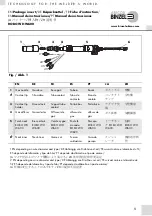
3
2.
Installation
For installation, places such as balconies and under eaves should be preferred, which will
not be exposed to direct rain and sun. In addition, care should be taken that the mounted
location is a place that is easily visible but not easily accessible.
Using the back plate of the siren or the template on the back of the cardboard box, mark
the mounting hole locations and the location of the cable entry hole. Drill the holes using a
8mm drill bit and insert the dowels. Using a drill bit longer than the wall thickness, drill the
cable hole so that it projects behind the wall. Mount the siren on the wall using the provided
screws and the appropriate size Phillips screwdriver. Do not forget to pass the cable
through the hole in the body. While mounting, adjust the tamper "switch" handle according
to the surface to be mounted. Do not forget to screw the protection plate to the device
during assembly.
!!! WARNING !!!: When assembling, make sure that the siren is at least 5 cm from all
sides of the wall
.
3.
Cable Connections
EXAMPLE: 4-line sabotage siren connection
Suggestions!!
If more than one siren is to be connected, one of the sirens is "EXT" and the other is "INT" to prevent the sirens from drawing too much current
from the panel. Sirens in the “INT” position are powered by their own batteries at the time of the alarm
.
4.
Battery Usage
•
VAS-741 B/R:
These sirens use a NiVH rechargeable battery with a capacity of 6V 350mAh and comes installed as a factory
default. Only after installation, the connector of the battery must be installed in the place indicated on the card.
WARNING !
Pay attention to the direction of the battery during installation, never use batteries other than the specified type,
voltage and size
ATTENTION !
In the absence of a rechargeable battery, the siren operates, but due to environmental conditions, shelf life of the
battery, it is not guaranteed to provide the expected performance at the time of the alarm or even to operate the
siren. Batteries must be checked periodically for this risk.
Piezzo Buzzer 1
Piezzo Buzzer 2
Microswithc 1
Battery






















